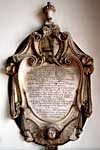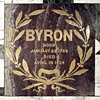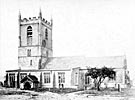For this church:    |
|
 Monument to Monument to Richard Byron |
The relationship between St Mary’s and the Byron family was displayed when the Byron vault was constructed early in the seventeenth century, at a time when their major interests were moving from Colwick to Newstead. Beginning in 1638 with the burial of Sir John Byron’s wife Cicile, St Mary’s housed the burials for thirteen members of the Byron family throughout the 1600s. As well as housing the vault, St Mary’s also has a number of memorial tablets dedicated to the Byron family. The oldest of this is a marble tablet – now seen on the north wall of the chancel – a memorial to the 2nd Lord Byron, Richard Byron who died in October 1679. Subsequent family members interred in the vault included the sixth Lord Byron, the poet.
Byron was the twenty-third and penultimate burial in the family vault. He died on 19 April 1824 at Missolonghi in Western Greece. After his death, Byron’s body was carried back to England, but his friends were unable to secure him a burial place in Westminster Abbey. Instead, his body was carried to Hucknall for burial. T. G. Barber, vicar of St Mary’s in 1907, described how the altar, pulpit, rails, and reading desk were draped with black material in preparation for Byron’s funeral in 1824.
On the day of his funeral the vicar, Charles Nixon met the body at the church gates, leading the procession through the main entrance of St Mary’s. It is said by Barber that for the first part of the service, the coffin and urn were placed on trestles, and then just before 4:00pm, they were lowered into the vault. On this occasion, Byron’s half-sister Augusta placed a marble tablet in his memory on the chancel wall, which can now be seen on the south wall of the chancel with the inscription: ‘In the vault beneath, where many of his ancestors and his mother are buried, lie the remains of George Noel Byron, Lord Byron of Rochdale...’
The burial place of a literary genius soon attracted the attention of many fellow writers, including Sir Walter Scott, Tennyson, Victor Hugo, Shelley, and Ruskin to name a few. Their testimonies to Byron's genius are now positioned on the north wall of the Lady Chapel.
 A point of focus for many visitors of Byron’s vault is the wreath positioned almost directly above the vault, inscribed with Byron’s birth and death dates. In Wright’s Directory of Nottinghamshire in 1910, he accounts for this memorial wreath, and informs us that it is made out of Rosso Antico marble, sent by the King of Greece in 1881. There was to be only one more burial in the vault after Lord Byron’s, and that was of his daughter, Ada Lovelace, in November 1852. After this the vault was closed, although it remains a prominent feature for many visitors to St Mary’s.
A point of focus for many visitors of Byron’s vault is the wreath positioned almost directly above the vault, inscribed with Byron’s birth and death dates. In Wright’s Directory of Nottinghamshire in 1910, he accounts for this memorial wreath, and informs us that it is made out of Rosso Antico marble, sent by the King of Greece in 1881. There was to be only one more burial in the vault after Lord Byron’s, and that was of his daughter, Ada Lovelace, in November 1852. After this the vault was closed, although it remains a prominent feature for many visitors to St Mary’s.
In 1743, Archbishop Herring’s visitation indicates the active role the church played in the community in Hucknall. Of 60 families in the parish only one was dissenting. Furthermore, there was strong religious practise and unity within the church, as all attendants were confirmed and baptised and public service was performed every Sunday.
The Rev Thomas Nixon, curate, told Archbishop Drummond in 1764 that Hucknall had 122 families, of whom about 20 were Methodists who ‘assemble whenever any strolling teacher passed that way.’ Hucknall had no public or charity school. He conducted a service every Sunday, alternately in the morning and evening, and administered Holy Communion at Easter, Whitsun, and Christmas.
However, with the exception of a gallery erected in the west end of the church to house choristers and musicians, there was little structural change to the church during the eighteenth century. In 1790 John Throsby confirmed that the church had ‘a tower with three bells, a nave and side aisle.’ Similarly, 60 years later, Samuel Lewis in his topographical dictionary of 1848 accounted no difference in the building of St Mary’s, with the exception of his account of the Byron vault, and the chancel to be a ‘neat mural monument’.
The religious census in 1851 gives us our first indication of the number of people attending St Mary’s services. The census records that the church had a potential total of 250 sittings, with an average total of 95 in the morning service and 208 in the afternoon. Interestingly, what the census also records is the church under a different name – St James’ parish church. The church had been named St James after it was noted that the village feast was near St James Day. However, an extract from Will of John de Sutton, vicar of Hucknall from 1414-1433 states ‘I give my soul to God and Saint Mary ... and my body to be buried in the churchyard of Hokenall’, suggesting that Saint Mary was the original dedicated saint.
 The church c.1870. The church c.1870. |
Sir Stephen Glynne visited St Mary’s on 15 May 1862 when he commented that the church was dilapidated, despite being the burial place of Lord Byron: ‘the condition of the church masks neglect and decay in no common degree’. He added that ‘the monument to Lord Byron is not remarkable’. Glynne provides us with a description of the church before the major renovations from the 1870s onwards.
This was discovered by Rev J.E. Phillips in 1884, and he restored the church to its original name of Hucknall St Mary Magdalene.
With its name change also came numerous changes to the building in the late nineteenth century, as St Mary’s underwent a period of restoration. Wright’s Directory records the building restoration as starting in 1871 and costing £3,292. These funds for the restoration have been accounted as coming from monetary gifts from the Duke of Portland, and John Godber as well as many others, showing the financial support St Mary’s had from certain people in the community during this time.
 Church in 1874 showing Church in 1874 showingnew south aisle |
The first of the changes saw the south aisle added and the original porch built in 1320 was moved to the south aisle. There was also the addition of a tiled roof to the nave and chancel. The interior of St Mary’s was embellished as the gallery was removed and the entire church was re-pewed.
Part of this embellishment saw the addition of the stained glass windows by the renowned glass artist C.E. Kempe, and to this day the church still houses 25 of these remarkable works of stained glass, making the church ‘one of the best places to go’ for studying Victorian stained glass, according to Pevsner. During the 1872 restoration the new south aisle had two windows added depicting scenes from the gospels, and the east window was also filled with stained glass.
According to Beardsmore’s account in 1909, at the large east window, one of the disciples at Emmaus is supposed to resemble Byron – something that visitors today can come to their own conclusion about!
The stained glass windows offer a visual reminder of the people who have served St Mary’s and were significant in the life of the church, for example, parishioners have been commemorated in the stained glass, such as John Godber (father of the canon) and churchwarden James Widdowson.
During the restoration, Canon Godber dedicated a window to the church, choosing the scene of Jesus commissioning Peter to ‘feed my lambs’, to act as a reminder of the pastoral duty of the canon. Therefore the addition of the stained glass windows at St Mary’s during the restoration served as a reminder and celebration of the value of the church within Hucknall community.
A second period of restoration at St Mary’s began in 1887 under the Rev J. E. Phillips and cost £4,846. This period saw work on the 12th century tower, chancel, and transepts, with a particularly focus on enlarging the church building and number of sittings. The rapid increase in population from 2,900 in the 1860s to 10,000 in the 1880s saw a demand for more space within the church.
The removal of the chancel meant that the sittings could be increased to 800, and spacious transepts were added to the north and south aisles of the church, between the nave and chancel. These two transepts, as noted by Wright, were unusually long and were the architectural work of R.C. Clarke.
Another area which saw restoration was the Lady Chapel, which was rebuilt and became the organ chamber and vestry until 1919.
More space was also made for the medieval font, as a baptistery house was built to the south of the tower. This was converted to a visitor centre in June 1999. The additions and extent of the enlargement of the church building was noted by Bishop Ridding, when his 1892 visitation he recorded that ‘the proportion of accommodation to the whole population is listed as one to ten in Hucknall Torkard.’
However, it seems that the enlargement and restoration of the church came at a cost, noted by J.C. Cox in 1912 who said that so much enlargement and restoration meant that very little of the old fabric was left remaining in St Mary’s. However, despite the sacrifice of losing the medieval framework, the Victorian restoration allowed the church to be preserved and remain open to the public.
The Victorian restoration saw a birth of new life in St Mary’s, as Pevsner wrote when visiting the church in 1951: ‘what is left of the old fabric is so restored that it looks as new as the new parts’. A new pulpit was dedicated in 1904 in memory of the Rev. J. E. Phillips, vicar throughout the Victorian restoration since 1879. The enlargement of the church saw services on Sunday at 10:30am and 6:30pm as well as Thursdays at 7pm, as recorded by Wright.
In addition, the church began to play a more active role in the community within Hucknall, demonstrated by the creation of the John Godber Centre in 1906.
 John Godber John Godber |
Godber was a significant figure in the life of St Mary’s, he was a Sunday school teacher whom after ordination served as curate, and a diocesan preacher. He gave generously to St Mary’s in time, work and money; he was passionate about seeing the church accommodating and catering for different groups in the community.
This passion fuelled him to build a new church hall to accommodate the Sunday schools, Boys Brigade, and Band of Hope. With land from the Duke of Portland, donations from the community and a gift of £5,000 in Godber’s last benefaction, the Godber Centre or ‘Godber Memorial Church Hall’ was opened on the 16 November 1906 by the Duchess of Portland and Bishop of Southwell. Sadly, Godber never got to see the opening of his building, as he died a couple of months before, in July 1906. However, the building continues his legacy, and today is used as a centre that offers something for all of the community in sport, drama, dance, flower arranging and children’s activities.
The centre continues to play an important role at St Mary’s as owned by the church and managed by a committee from the congregation. The pinnacle of the centre’s influence on the community of Hucknall was displayed at the centenary of the building in 2007. The Lovelace theatre group performed a show celebrating the 100 years of the centre, taking the audience through the different groups that it has housed in the last century. The centre stands as an example of St Mary’s involvement in the lives of the people of Hucknall throughout the 1900s.
From 1939-1945, there has been no evidence to suggest that the church of St Mary’s was damaged or affected by the Second World War bombings. However during the war, Hucknall played an important role as the location of the first flight of a P-51 Mustang fighter-bomber plane in the aerodrome, which had been fitted with the new and superior Rolls-Royce Merlin Engine.
Additionally, the William’s factory in 1940 was bombed out of London and relocated to Caddow Avenue in Hucknall, making services uniforms for the war. Therefore Hucknall was involved in war activity, and St Mary’s paid its respects to those who died in both the 1914-1919 Great War and Second World War. Along with the war memorials are stained glass windows in the Lady Chapel, one is for the memory of two young soldiers, showing the crests of their regiments.
The other window, given by the Boys Brigade, is to honour and remember their fellow comrades who also died during the wars. Another memorial that was erected in 1933 was that of philanthropist Dr Zachariah Green, remembered for his great charitable work. In his memory an altar rail for the Lady Chapel was given by his family. Memorials such as this, along with the war memorial, and the Byron vault demonstrate how St Mary’s became a home to many.
In 2013 St Mary’s opened its doors to many visitors throughout the week. It has a visitors’ centre, and the Byron memorials are a popular attraction. As one of the oldest buildings in Hucknall, much of the history and identity of the town can be seen in St Mary’s. However, despite being a medieval church only the tower now remains of the original 12th century work. St Mary’s best represents the Victorian period with its tributes to the English Romantics, the Victorian stained glass windows and the building work of the Victorian restoration.






